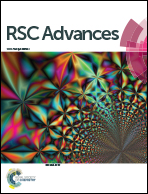Combinatorial effects of non-thermal plasma oxidation processes and photocatalytic activity on the inactivation of bacteria and degradation of toxic compounds in wastewater†
Abstract
The simultaneous presence of hazardous chemicals and pathogenic microorganisms in wastewater is tremendously endangering the environment and human health. Therefore, developing a mitigation strategy for adequately degrading toxic compounds and inactivating/killing microorganisms is urgently needed to protect ecosystems. In this paper, the synergetic effects of the photocatalytic activity of TiO2 and Cu–TiO2 nanoparticles (NPs) and the oxidation processes of non-thermal atmospheric pressure plasma (NTAPP) were comprehensively investigated for both the inactivation/killing of common water contaminating bacteria (Escherichia coli (E. coli)) and the degradation of direct textile wastewater (DTW). The photocatalytic NPs were synthesized using the hydrothermal method and further characterized employing field emission scanning electron microscopy (FESEM), X-ray diffraction (XRD), ultraviolet-visible diffuse reflection spectroscopy (UV-Vis DRS) and photoluminescence (PL). Results revealed the predominant presence of the typical anatase phase for both the flower-like TiO2 and the multipod-like Cu–TiO2 structures. UV-Vis DRS and PL analyses showed that the addition of Cu dopants reduced the bandgap and increased oxygen defect vacancies of TiO2. The inactivation of E. coli in suspension and degradation of DTW were then examined upon treating the aqueous media with various plasma alone and plasma/NPs conditions (Ar plasma, Ar + O2 plasma and Ar + N2 plasma, Ar plasma + TiO2 NPs and Ar plasma + Cu–TiO2 NPs). Primary and secondary excited species such as OH˙, O, H and N2* generated in plasma during the processes were recognized by in situ optical emission spectrometry (OES) measurements. Several other spectroscopic analyses were further employed to quantify some reactive oxygen species (ROS) such as OH, H2O2 and O3 generated during the processes. Moreover, the changes in the pH and electrical conductivity (EC) of the solutions were also assessed. The inactivation of bacteria was examined by the colony-forming unit (CFU) method after plating the treated suspensions on agar, and the degradation of organic compounds in DTW was further validated by measuring the total organic carbon (TOC) removal efficiency. All results collectively revealed that the combinatorial plasma-photocatalysis strategy involving Cu–TiO2 NPs and argon plasma jet produced higher concentrations of ROS and proved to be a promising one-step wastewater treatment effectively killing microorganisms and degrading toxic organic compounds.



 Please wait while we load your content...
Please wait while we load your content...